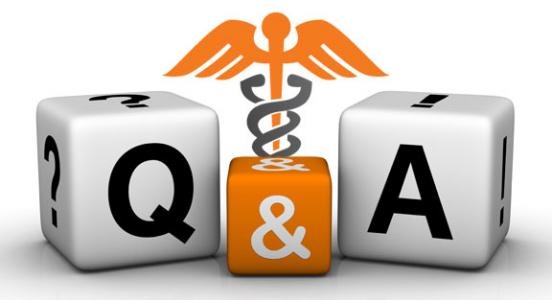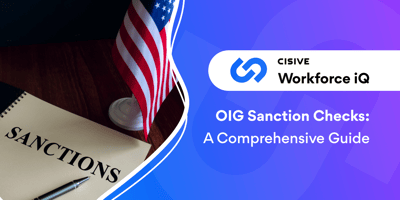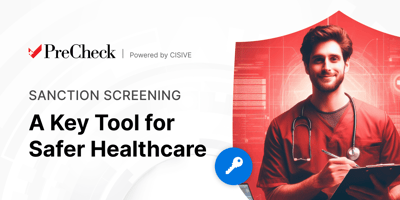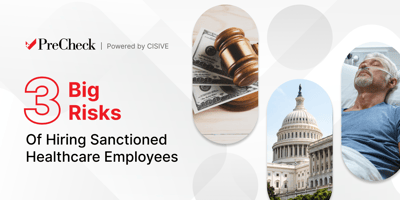

In the complex world of healthcare, OIG sanction checks are non-negotiable. These checks are far...

As PreCheck’s Principal Consultant for Sanction Screening, I work with healthcare compliance officers every day to protect their facilities from excluded individuals and entities. With over ten years conducting sanction checks, I’ve seen dozens of scenarios and have helped clients identify physicians, employees and vendors who have been excluded from participating in federal health programs. The following are a few questions that I’ve been asked by our clients and prospective clients—some more often than others.
As an industry best practice, I would recommend checking the Office of Inspector General’s (OIG) List of Excluded Individuals and Entities (LEIE) and General Services Administration’s (GSA) System for Award Management (SAM) database as well as all of the publicly available State Medicaid Exclusion Lists. Most healthcare experts concur that both lists should be checked, but it’s also highly recommended that organizations check State Medicaid Exclusion Lists. We’ve seen some healthcare facilities check their local state Medicaid exclusion list, but they fail to check more than 30 other available lists that could contain an excluded individual on their staff. It really depends on the level of risk that you’re comfortable for your organization.
Again, this is something that depends on your healthcare organization’s comfort zone for risk management. If you don’t have a progressive exclusion and sanction screening program, you may find yourself having to explain to your management why an excluded individual was on your payroll for three or four months before you caught it. These are the types of situations that you should consider as you decide on the frequency of your exclusion screening policy. There are healthcare organizations that check everything—the OIG LEIE, the GSA SAM, and the State Medicaid Exclusion Lists every month to ensure they are checking every available source with the latest information. It’s up to each healthcare organization to decide how frequently to conduct sanction checks, but the OIG updates the LEIE on a monthly basis. Therefore, screening healthcare staff and contractors on a monthly basis provides the highest level of mitigated risk.
The answer is not a straight-forward one. According to the OIG’s Special Advisory Bulletin issued in May 2013, healthcare organizations cannot make payments to excluded providers. Since at least 1999, organizations have been able to screen the OIG LEIE to determine whether individuals are excluded from federal health programs. While healthcare providers are not required by a specific statute or regulation to check the LEIE, the OIG provides the exclusion list as a tool for providers to identify potential employees or contractors who are excluded. If your organization fails to screen for excluded individuals and entities, you could be subject to Civil Monetary Penalties (CMPs). While it is not a requirement, checking for exclusions and sanctions is an industry best practice and could save your organization from costly fines.
Section 6501 of the Affordable Care Act (ACA) requires States to terminate the participation of any individual or entity if they are terminated under Medicare or any other Medicaid State Plan. At first glance, it would seem that termination would be the reasonable thing to do in this situation. However, this is only applicable to terminations occurring on or after the effective date of January 1, 2011. If this particular employee was excluded in 2004, for example, then he or she would be excluded only in the state that excluded them. Thus, if the state that excluded them is not your state, the Affordable Care Act does not mandate that you terminate them.
It’s understandable that price is often a factor in considering both the frequency of your sanction checking program, as well as your provider. However, make sure that you consider other factors rather than just going with the lowest price. Not all exclusion screening providers are equal. Some companies can offer you a cheap price, but they may provide you with a report that consists of a ‘data dump’. In other words, the burden will be on you to decide whether the excluded individual on the report is your employee. If you are considering outsourcing your sanction checks, make sure your vendor has a staff of highly trained professional licensed private investigators who can provide a higher level of service by investigating further to determine whether or not the sanctioned individual on the report is actually an employee on your payroll. This will save your staff considerable time and several headaches from having to decipher the unclear ‘data dump’ reports.

In the complex world of healthcare, OIG sanction checks are non-negotiable. These checks are far...

Healthcare organizations are responsible for ensuring they hire trustworthy employees and engage in...

Healthcare sanctions background checks play a vital role in safeguarding patients, protecting...